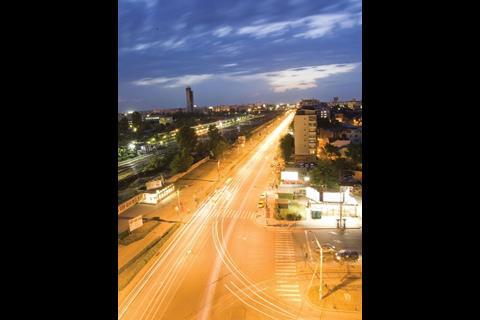Romania is booming after its recent accession to the EU, with a rapidly growing construction industry and the world’s ‘third most promising’ economy, writes Stuart Powls of EC Harris
01 The Romanian economy
Like many countries of the former Eastern bloc, the Romanian economy surged when the shackles were taken off, although not without problems.
Economic growth has been among the strongest in the region, rising from a GDP of 2.4% in 2002 to 8.3% in 2004. There was a slowdown in 2005 but by the end of 2006 GDP had picked up to about 8% and is expected to be at about 8.4% over the next five years.
Inflation, which had been a problem for some years, dropped markedly from 17.1% in 2002 to about 8% in 2005 and should fall to about 5-6% this year, mainly owing to the requirements of EU accession. The official inflation target for 2007 is 4.4%, but some observers have noted that Romania’s consumer price index fails to accurately reflect the true impact of energy costs, which are rising faster than average.
Romania joined the EU in January 2007, and as a result, investment in the country is expected to increase. Romania is considered by multinationals to be a booming market and was ranked the third most promising economy after Russia and Turkey for 2006-2007.
Industrial production has made a remarkable recovery after a series of heavy shocks primarily owing to a severe appreciation of the domestic currency caused by capital inflows and a sharp rise in energy prices. However, exports have been growing rapidly, up by over 18% in the first half of this year.
Budget revenues have been bulging and have helped to finance education and infrastructure at a time when EU accession is putting pressure on the government to boost the production of public goods. Unemployment is slightly above 5%, though this is largely because of massive migration to other EU states, particularly Italy and Spain.
However, there are still problems, not least political instability. In May 2007 Traian Basescu, the Romanian president, only just survived a parliamentary bid to unseat him after receiving backing from voters in a referendum.
On the financial side, current account deficits are rising and external borrowing by the private sector is surging as commercial banks attempt to capitalise on the country’s assumed bright prospects.
Meanwhile, a number of other factors point to a more sober view for the longer term. These include inflationary pressures caused by a rise in aggregate demand after accession, a monetary policy regime that implies exchange rate flexibility, a likely increase in the burden on the public budget following EU accession and the need to develop domestic infrastructure. There is also the problem that government tax revenues are still below where they should be. This is down to an inconsistent approach to taxation of the masses and also wide-scale tax avoidance and use of the cash economy.
The Romanian economy needs more fixed investment and better infrastructure and needs to be sustaining growth rates of above 6% yearly over the longer term. Unlike when the 2.5% of GDP budget deficit target was undershot, the Economist Intelligence Unit expects the 2007 deficit to be larger than planned, at about 3% of GDP. A recent World Bank report hails Romania’s reforms and creates high expectations for post-accession years, although a growth rate that ranges between 5.5-6% annually is more likely in the long term with about 6% expected in 2007.
02 The construction market
According to the Romanian Association of Constructors, the value of the domestic construction market was approximately €5.2bn (£3.5bn) at the end of 2006.
Output in the construction industry increased by 10% in 2005 and 9.9% in 2006. Looking forward, further increases are expected of 12% in both 2007 and 2008 and the value of the industry is estimated to reach €10bn (£6.8bn) in 2010, by which time the number of employees is expected to reach 500,000, compared with 360,000 in 2005.
The growth of the market is impressive especially in terms of real value, rather than volume, because of the rising cost of construction materials. Overall, the construction sector remains one of the most dynamic in the Romanian economy.
03 Infrastructure
Outside Bucharest, one of the main focuses for the Romanian construction market is infrastructure, which accounts for about 16% of the construction market. Romania’s transport infrastructure will get a direct boost from the EU, with €4.5bn (£3.1bn) to be provided over time to upgrade the country’s road and rail networks. The Romanian state railway will be able to tap into €3.2bn (£2.2bn) to repair the country’s network to redirect freight transport away from roads.
The EU assistance to the roads programme revolves around the European corridors IV and IX. The high allocation of funds for infrastructure in the new budget includes €400m (£272m) for roads. There is expected to be further growth in roads with an extra 1,200km of highway by 2013, by which time a further 8,500km will be updated. Other investment is going on environmental protection programmes while foreign companies are investing in modernising harbours, particularly in Constanza on the Black Sea and river ports on the Danube.
04 Private investment in construction
Romania is benefiting from huge amounts of inward investment, particularly in Bucharest, as property developers and investors attempt to get in while the market is still on the ground. The country suffers from a shortage of modern property but investors believe that this market is about to mature as Hungary’s and the Czech Republic’s did before them.
Real estate investors face legal issues regarding uncertainty over title. There are potential problems over building permits and an inconsistency in the approach by local authorities. However instability is not regarded as a deterrent to international investors who see it as a nuisance rather than a real obstacle. For most foreign investors, the attention is focused on the construction of office buildings, hotels, shopping areas and hypermarkets. The residential sector rose by 40% in 2006 although only 6,000 units were delivered in Bucharest and the residential market has a comparatively low share of the total construction market.
On the private commercial front, office take-up almost doubled between 2003 and 2005 and it is estimated that office space planned for 2007 and 2008 is approaching 500,000m2. In Bucharest, the central-north and north districts are the leading sub-markets while three new office parks are planned on the city’s outskirts.
Demand for high quality retail space is also high, with many international brands eager to enter the market but still trying to find the right space. The three shopping malls in Bucharest will soon be joined by five new shopping centres and the stock of modern retail area could increase four-fold by the end of 2009.
Demand for industrial space is also high, and the market is set to expand significantly.
With 2.2 million people, Bucharest has one of Eastern Europe’s largest city populations and its rate of development has seen land prices double over the past 18 months, according to Jones Lang LaSalle.
05 Construction activity
Romania has a very dynamic construction market and most industry forecasts are for a continued increase in growth for the next three-to-four years. In 2007 the construction market is estimated to grow 15%.
However, construction inflation is a real worry. When money is finally leveraged from EU funds for large scale infrastructure projects such as road, rail and aviation, there will be even greater pressure on the supply chain than that currently being experienced.
There are a number of factors driving growth:
- High demand in the private sector, especially in the residential sector from a growing young population employed in the banking sector with high levels of disposable income
- Demand by multinational corporations for office space in Bucharest
- Massive investment from foreign investors
- A boom in foreign financial programs
- EU funding on infrastructure investment
- Increased investment in public budgets for schools, healthcare, and so on.
06 Construction costs
Against the background of increasing workload there are two issues that will affect construction costs: shortage of construction materials and lack of manpower.
On the materials side demand is high and, despite the fact that imports are more readily available and the fact that Turkey and other neighbours have positioned themselves to take advantage of the situation, there is evidence of rising prices based on growing utilities and raw materials prices. As a result, it is estimated that construction material costs may rise by 5-15% in 2007.
On the labour side, since Romania joined the EU in January, the EU has become a very serious competitor for the Romanian skilled labour market. This lack of manpower has led to growing labour costs for both skilled and unskilled workers and it is estimated that labour costs could increase by 15-20% in 2007.
With the current situation on labour and materials, and based on a general inflation rate in the economy of about 6%, it is expected that general construction costs will increase by at least 9% and perhaps be as much as 15% over the coming year.
07 Materials and labour
See table attached
08 1st quarter 2007 price levels */m2
See graphic attached
Downloads
1st quarter 2007 price levels €/m2
Other, Size 0 kb
Postscript
EC Harris is an international consultancy working on the real estate, infrastructure and construction sectors. The firm brings together professional skills, developed processes and information to deliver all aspects of a capital project and its operation. This consultancy can advise on the initial investment through each stage of construction to occupation and day-to-day operations. EC Harris has 43 wholly owned offices worldwide employing more than 3,000 people and an annual group turnover of £200m.


























No comments yet